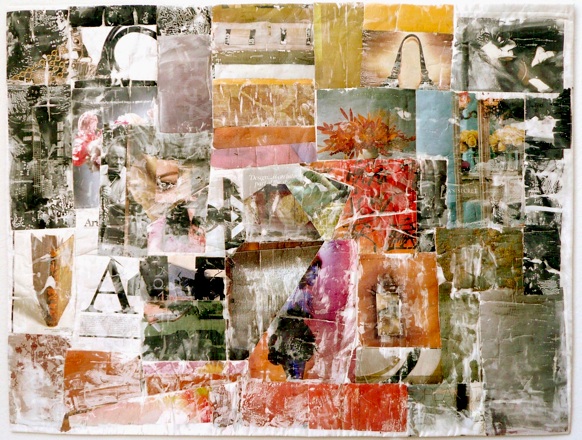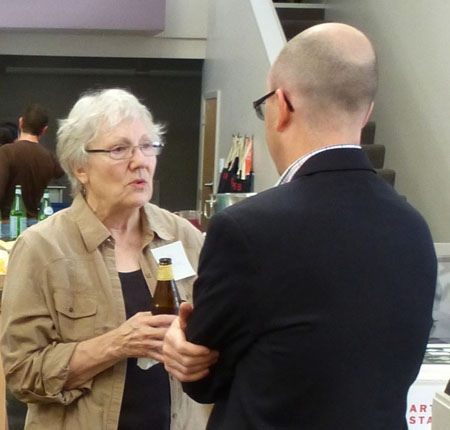A series of conversations with SFCB Director of Development, Jeff Thomas and the donors and supporters of the San Francisco Center for the Book.
 Joan Schulze City Woman 2010 38" x 50"
Joan Schulze City Woman 2010 38" x 50"
In Conversation With Artist Joan Schulze
June 2013
Q: Tell me a bit about your background and your art and specifically book art experience.
I can’t remember a time when I didn’t make books. In second or third grade (Chicago Public Schools) we could come and sit in the classroom before school and make a Before the Bell book. It was a simple folded form which we filled with answers to questions and math problems the teachers wrote on the board. If time permitted we could draw in the book. The teacher marked it and gave it to us to take home at the end of the day.
When I became an elementary school teacher I continued this practice by introducing simple bookmaking as a way to complete a unit of study. Students made books for their short stories, poems, and drawings. It was a perfect way to mark the ending of a unit of activity. I don’t remember thinking it was an unusual practice.
Over the years I have taught myself the Japanese sewn book, pamphlet stitched books, and larger bound books. In my workshops (collage; fiberart techniques; quiltmaking; alternative printing; design; fan design and construction) I introduced simple bookbinding to encourage students to organize handouts, exercises and personal notes. Many of my students, especially in Australia and Europe have become involved in the book arts.
My 4 children and 13 grandchildren have made books with me or each other. In 2009 I produced a limited edition book, “and other stories.” This boxed set of 20 collages includes a short story.
Q: How did you come to know San Francisco Center for the Book?
In the middle 90s I met Kathleen Burch at a book fair. She was manning a table for PCBA. I joined right then. I acquired my SF studio in December 1995. Center for the Book moved to my Potrero Hill neighborhood 6 months later. Since then I have been as active as possible. How lucky can one be?
Q: Why do you feel SFCB is a worthy investment for donors?
SFCB serves such a diverse audience from near and far. It has produced exceptional events over the years. Its unique educational program is comprehensive and keeps on growing. The center’s new space fits the ambitions of the founders, staff and board which makes it even more worthy of support.
Q: What do you feel to be the Center’s greatest asset and greatest challenge?
Kathleen Burch and Mary K. Austin essentially created the center as a start-up using their creativity and funds. They continue to provide energy and ideas which has served the center well. This cannot be underestimated. However as in any business, the future has to be planned for. Who will replace these dynamic founders?
Q: What is your favorite part of the Center’s new space?
Walking in from the street and being dazzled by the welcoming entrance and how the space reveals itself.
Q: What are your hobbies and passions?
My devotion to making art continues unabated.

About Joan Schulze
